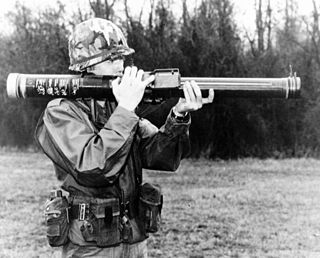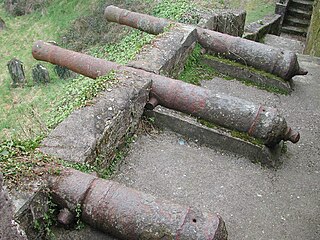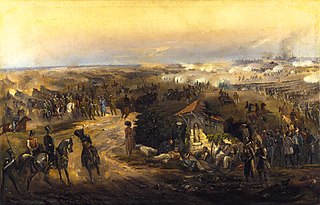
An armoured fighting vehicle or armored fighting vehicle (AFV) is an armed combat vehicle protected by armour, generally combining operational mobility with offensive and defensive capabilities. AFVs can be wheeled or tracked. Examples of AFVs are tanks, armoured cars, assault guns, self-propelled artilleries, infantry fighting vehicles (IFV), and armoured personnel carriers (APC).

Artillery are ranged weapons that launch munitions far beyond the range and power of infantry firearms. Early artillery development focused on the ability to breach defensive walls and fortifications during sieges, and led to heavy, fairly immobile siege engines. As technology improved, lighter, more mobile field artillery cannons developed for battlefield use. This development continues today; modern self-propelled artillery vehicles are highly mobile weapons of great versatility generally providing the largest share of an army's total firepower.
A cannon is a large-caliber gun classified as a type of artillery, which usually launches a projectile using explosive chemical propellant. Gunpowder was the primary propellant before the invention of smokeless powder during the late 19th century. Cannons vary in gauge, effective range, mobility, rate of fire, angle of fire and firepower; different forms of cannon combine and balance these attributes in varying degrees, depending on their intended use on the battlefield. A cannon is a type of heavy artillery weapon.

Self-propelled artillery is artillery equipped with its own propulsion system to move toward its firing position. Within the terminology are the self-propelled gun, self-propelled howitzer, self-propelled mortar, and rocket artillery. They are high mobility vehicles, usually based on continuous tracks carrying either a large field gun, howitzer, mortar, or some form of rocket/missile launcher. They are usually used for long-range indirect bombardment support on the battlefield.

A field gun is a field artillery piece. Originally the term referred to smaller guns that could accompany a field army on the march, that when in combat could be moved about the battlefield in response to changing circumstances, as opposed to guns installed in a fort, or to siege cannons and mortars which are too large to be moved quickly, and would be used only in a prolonged siege.

The Battle of Borodino took place near the village of Borodino on 7 September [O.S. 26 August] 1812 during Napoleon's invasion of Russia. The Grande Armée won the battle against the Imperial Russian Army, but failed to gain a decisive victory and suffered tremendous losses. Napoleon fought against General Mikhail Kutuzov, whom the Emperor Alexander I of Russia had appointed to replace Barclay de Tolly on 29 August [O.S. 17 August] 1812 after the Battle of Smolensk. After the Battle of Borodino, Napoleon remained on the battlefield with his army; the Imperial Russian forces retreated in an orderly fashion southwards. Because the Imperial Russian army had severely weakened the Grande Armée, they allowed the French occupation of Moscow, using the city as bait to trap Napoleon and his men. The failure of the Grande Armée to completely destroy the Imperial Russian army, in particular Napoleon's reluctance to deploy his Imperial Guard, has been widely criticised by historians as a huge blunder, as it allowed the Imperial Russian army to continue its retreat into territory increasingly hostile to the French. Approximately a quarter of a million soldiers were involved in the battle, and it was the bloodiest single day of the Napoleonic Wars.

A regiment is a military unit. Its role and size varies markedly, depending on the country, service, or specialisation.

Jäger is a German military term referring to specific light infantry units.

Anti-tank warfare originated from the need to develop technology and tactics to destroy tanks during World War I. Since the Allies deployed the first tanks in 1916, the German Empire developed the first anti-tank weapons. The first developed anti-tank weapon was a scaled-up bolt-action rifle, the Mauser 1918 T-Gewehr, that fired a 13.2 mm cartridge with a solid bullet that could penetrate the thin armor of tanks at that time and destroy the engine or ricochet inside, killing occupants. Because tanks represent an enemy's strong force projection on land, military strategists have incorporated anti-tank warfare into the doctrine of nearly every combat service since. The most predominant anti-tank weapons at the start of World War II in 1939 included the tank-mounted gun, anti-tank guns and anti-tank grenades used by the infantry, and ground-attack aircraft.

In military organizations, an artillery battery is a unit or multiple systems of artillery, mortar systems, rocket artillery, multiple rocket launchers, surface-to-surface missiles, ballistic missiles, cruise missiles, etc., so grouped to facilitate better battlefield communication and command and control, as well as to provide dispersion for its constituent gunnery crews and their systems. The term is also used in a naval context to describe groups of guns on warships.

A tank gun is the main armament of a tank. Modern tank guns are high-velocity, large-caliber artilleries capable of firing kinetic energy penetrators, high-explosive anti-tank, and cannon-launched guided projectiles. Anti-aircraft guns can also be mounted to tanks.

Canister shot is a kind of anti-personnel artillery ammunition. Canister shot has been used since the advent of gunpowder-firing artillery in Western armies. However, canister shot saw particularly frequent use on land and at sea in the various wars of the 18th and 19th century. Canister is still used today in modern artillery.

The Battle of Segesvár, also called the Battle of Fehéregyháza, was a battle in the Hungarian Revolution of 1848, fought on 31 July 1849 between the Hungarian revolutionary army under the command of Lieutenant General Józef Bem and the Russian V Corps under General Alexander von Lüders. The battle ended with the victory of the Russian army, which was presumably the death location of the Hungarian poet and national hero Sándor Petőfi, but his body was never found. Furthermore, The Chief of Staff Russian V corps, General Grigory Skariatin was killed at the battle. Although heavy, the defeat was not decisive for the Hungarian army of Transylvania, Lieutenant General Józef Bem continuing his resistance in the province until the Battle of Nagycsűr on 6 August 1849.

The Field Artillery Branch is a combat arms branch of the United States Army that is responsible for field artillery.

Field artillery is a category of mobile artillery used to support armies in the field. These weapons are specialized for mobility, tactical proficiency, short range, long range, and extremely long range target engagement.

Horse artillery was a type of light, fast-moving, and fast-firing artillery which provided highly mobile fire support, especially to cavalry units. Horse artillery units existed in armies in Europe, the Americas, and Asia, from the early 17th to the mid-20th century. A precursor of modern self-propelled artillery, it consisted of light cannons or howitzers attached to light but sturdy two-wheeled carriages called caissons or limbers, with the individual crewmen riding on horses. This was in contrast to the rest of the field artillery, which were also horse-drawn but whose gunners were normally transported seated on the gun carriage, wagons or limbers.

The Battle of Debrecen was fought on August 2, 1849, between the Hungarian Revolutionary Army and forces of the Russian Empire, which intervened on behalf of the Austrian Empire to suppress the Hungarian revolution. On 30 July 1849, the commander of the Hungarian Army of the Northern Danube, General Artúr Görgei split his army in two, while he and the main part of his army marched towards Arad, he ordered to the I corps under the leadership of József Nagysándor to flank him from West against the Russians, by marching parallelly with his troops towards Debrecen. Nagysándor's I. corps was attacked and defeated by the hugely outnumbering Russian main army under Marshal Ivan Paskevich. This battle enabled Görgei to win a distance of several days from the Russian army, creating the possibility for him to join his armies with the Hungarian troops concentrated in Southern Hungary, and to defeat the Austrian main army of Field Marshal Julius Jacob von Haynau, before the Russians arrived. It was not Görgei's fault that this plan did not materialize.

The Second Battle of Komárom, also known as the Battle of Ács, took place on 2 July 1849 between the Hungarian Revolutionary Army and the Imperial Austrian Army of the Austrian Empire ; a contingent of almost 12,000 Russian Empire troops was led by Lieutenant General Fyodor Sergeyevich Panyutyin. The Austrian army outnumbered the Hungarian troops two to one, and had a multitude of infantry, light infantry, heavy cavalry (cuirassiers), and better weapons. The Hungarians, except for the Landwehr and the hussars, had few types of military units. Other problems also negatively impacted the Hungarian army. The Lajos Kossuth government decided to withdraw the Hungarian troops from Komárom to southern Hungary without consulting Görgei, the war minister, the only one authorised to make a military decision. Görgei grudgingly agreed to the decision, fixing the date of departure for southern Hungary to 3 July. Uncertainty and conflicts existed among the Hungarian officers and soldiers before the attack. Kossuth sent Lieutenant General Lázár Mészáros to Komárom to relieve Görgei of leadership and send him to Pest. When Mészáros approached Komárom by steamboat on 2 July, however, he heard gunfire from the battle and returned to Pest.

The main aim of the third Battle of Komárom was to push back the Austrian army, easing the task of the Hungarian army to retreat towards South-East. The Hungarian Government agreed on a Hungarian attack against the Austrian troops led by Julius Jacob von Haynau, which was stationing to East and South-East from the fortress of Komárom. On 11 July the Hungarian army started to attack the Austrians. Although General Artúr Görgei was the commander of the Hungarian Army of the Upper Danube, General György Klapka took over the command of Görgey's army because of Görgey's injury in the Second Battle of Komárom from 2 July 1849. New Hungarian troops arrived under the command of Ármin Görgey, and from Bátorkeszi under József Nagysándor, decreasing the Hungarian numerical disadvantage in relation to the Austrian army led by Julius Jacob von Haynau.

The Battle of Pered, fought on 20–21 June 1849, was one of the battles which took place in the Summer Campaign of the Hungarian War of Independence from 1848 to 1849, fought between the Hungarian Revolutionary Army and the Habsburg Empire helped by Russian troops. The Hungarian army was led by General Artúr Görgei, while the imperial army by Lieutenant field marshal Julius Jacob von Haynau. After several preliminary minor battles of the Hungarian and Austrian troops along the Vág river, in which the attacking Hungarians could not achieve success, Görgei took the command of his troops, and after receiving reinforcements, on 20 June, put his troops to attack again towards West. Although the II. Hungarian army corps occupied in heavy fights the village of Pered, the other two corps were unsuccessful, and could not advance. The angered Görgei removed the commander of the III. corps, General Károly Knezić because of his inactivity, and Colonel Lajos Asbóth, the commander of the II. corps who, in contrast to Knezić, was the only commander who accomplished his duties. While Knezić's place was taken by Colonel Károly Leiningen-Westerburg, who was a great choice, Asbóth's place was taken by Colonel József Kászonyi, who was an explicitly bad choice. Haynau, who on the first day of the battle was moving the bulk of his troops to cross the Danube to start an attack on its southern bank, sent three of his corps, which were still on the northern bank, to repel the Hungarian forces. The two Austrian and one Russian corps started their attack on 21 June and forced the Hungarians to retreat from Pered and Zsigárd, which forced Görgei to order his troops to retreat from the battlefield.



















